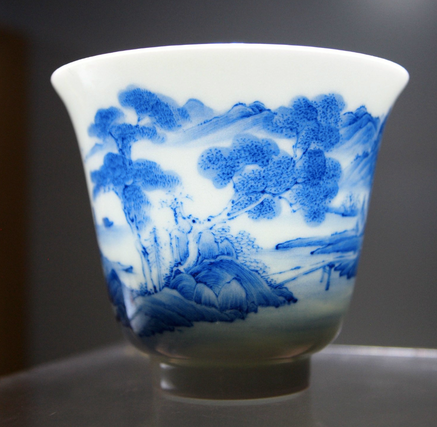3 Ways of Painting Porcelain
(Originally published January 6, 2019)
This week we look at the different styles and techniques of Chinese porcelain, beginning with the choice of layering for the paint and the glaze. Porcelain artists have a very basic choice to make before they begin to paint their pieces. The choice is whether to use 1) Youxiacai 釉下彩, painting under the glaze; 2) youzhongcai 釉中彩, painting in between glazes; 3) youshangcai 釉上彩, painting on the surface of the glaze. While it may seem unimportant, this choice will dictate what colours can be used, the final appearance of the painting, and even the surface texture of the piece. Each method has its own history and uses.

An example of youxiacai glazed porcelain using Qinghua and Youlihong paint.
Youxiacai
Youxiacai Began during the Song Dynasty. Youxiacai is applied on unglazed porcelain that has not yet been fired or that has only been bisque fired (a low-temperature firing to dry out the clay). It is painted directly on the porcelain body and then is covered with a transparent glaze. It is then fired at a high temperature (usually between 1200-1300°C). The color choices for the painting are limited to those that will do well fired at that high temperature range. Two examples are cobalt blue, used in Qinghua 青花 “blue and white” porcelain, and youlihong 釉里红, a characteristic red that is often paired with cobalt blue. After firing youxiacai porcelain is very smooth, almost like glass. The colour will never fade and is trapped under the glaze.

Qinghua painting - Youxiacai using cobalt blue on white porcelain

Youxiacai using cobalt blue and youlihong red.
Youzhongcai
Youzhongcai Was adopted in the 1970s. Youzhongcai begins by firing a clear glaze over a porcelain body. Paint is then applied to the glazed porcelain, and then another layer of transparent glaze is applied over the paint. The piece is then fired for around 90 minutes at a high temperature of over 1200°C. The advantage of this method is that the short final firing period allows a greater range of color choices and materials than youxiacai, which can only use colors able to withstand a long firing period at very high temperatures. The high temperature still needs to be taken into account as some pigments may change colour at different firing ranges. Youzhongcai also appears glass-like and traps the paint below the glaze. Youzhongcai can appear similar to youxiacai.

Youzhongcai glazed gaiwan with colorful flower painting
Youshangcai
Youshangcai Originated during the Ming Dynasty. The porcelain body with a clear glaze is fired first at a high temperature and emerges from the kiln as finished glazed porcelain. The piece is then painted and fired at a lower temperature (between 650-800°C). Most pigments can be fired at this range without losing their colour or quality, and as a result youshangcai can feature a wide range of colours. Because no glaze is applied over the painting, you can feel the texture of the painted area over the porcelain. It is ideal for colourful paintings or patterns with great detail, and is often used for porcelain fine art paintings and vases.

Youshangcai painted porcelain vase
Although most painted Chinese porcelain fall under one of these three categories, more than one of these methods can be used together in one piece. Read our next entry to learn about combining these methods to produce a very special painted porcelain called "Doucai."
